Mazda Mazda6: Brake System
 Mazda Mazda6: Brake System
Mazda Mazda6: Brake System
Foot Brake
Your Mazda has power-assisted brakes that adjust automatically through normal use.
Should power-assist fail, you can stop by applying greater force than normal to the brake pedal. But the distance required to stop will be greater than usual.
WARNING:
Do not coast with the engine stalled or turned off, find a safe place to stop:
Coasting with the engine stalled or turned off is dangerous. Braking will require more effort, and the brake's power-assist could be depleted if you pump the brake. This will cause longer stopping distances or even an accident.
Shift to a lower gear when going down steep hills:
Driving with your foot continuously on the brake pedal or steadily applying the brakes for long distances is dangerous. This causes overheated brakes, resulting in longer stopping distances or even total brake failure. This could cause loss of vehicle control and a serious accident. Avoid continuous application of the brakes.
Dry brakes that have become wet by driving very slowly and applying the brakes lightly until brake performance is normal:
Driving with wet brakes is dangerous. Increased stopping distance or the vehicle pulling to one side when braking could result in a serious accident. Light braking will indicate whether the brakes have been affected.
Parking Brake
WARNING:
Before leaving the driver's seat, always switch the ignition off, set the parking brake, and make sure the shift lever is in P (automatic transaxle) or in 1st gear or R (manual transaxle):
Leaving the driver's seat without switching off the ignition, setting the parking brake, and shifting the shift lever to P (automatic transaxle) or to 1st gear or R (manual transaxle) is dangerous. Unexpected vehicle movement could occur which could result in an accident.
In addition, if your intention is to leave the vehicle for even a short period, it is important to switch the ignition off, as leaving it in another position will disable some of the vehicle's security systems and run the battery down.
CAUTION:
Driving with the parking brake on will cause excessive wear of the brake linings or pads.
NOTE:
For parking in snow, refer to Winter Driving regarding parking brake use.
Setting the parking brake
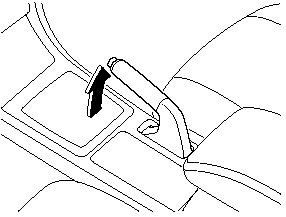
Depress the brake pedal and then firmly pull the parking brake lever fully upwards with sufficient force to hold the vehicle in a stationary position.
Releasing the parking brake
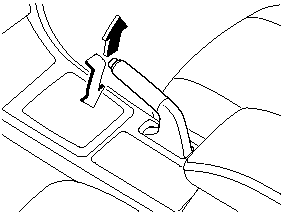
Depress the brake pedal and pull the parking brake lever upwards, then press the release button. While holding the button, lower the parking brake lever all the way down to the released position.
Brake System Warning Light
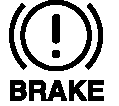
This warning has the following functions:
Parking brake warning
The light illuminates when the parking brake is applied with the ignition switched to START or ON. It turns off when the parking brake is fully released.
Low brake fluid level warning
If the light stays on after the parking brake is fully released, you may have a brake problem.
Drive to the side of the road and park off the right-of-way.
You may notice that the pedal is harder to depress or that it may go closer to the floor. In either case, it will take longer to stop the vehicle.
1. With the engine stopped, open the hood and check the brake fluid level immediately, and then add fluid if required.
2. After adding fluid, check the light again.
If the warning light remains on, or if the brakes do not operate properly, do not drive the vehicle. Have it towed to an Authorized Mazda Dealer.
Even if the light turns off have your brake system inspected as soon as possible by an Authorized Mazda Dealer.
NOTE:
Having to add brake fluid is sometimes an indicator of leakage. Consult an Authorized Mazda Dealer as soon as possible even if the brake light is no longer illuminated.
WARNING:
Do not drive with the brake system warning light illuminated. Contact an Authorized Mazda Dealer to have the brakes inspected as soon as possible:
Driving with the brake system warning light illuminated is dangerous. It indicates that your brakes may not work at all or that they could completely fail at any time. If this light remains illuminated, after checking that the parking brake is fully released, have the brakes inspected immediately.
Anti-Lock Brake System (ABS)
The ABS control unit continuously monitors the speed of each wheel. If one is about to lock up, the ABS responds by automatically releasing and reapplying that wheel's brake.
The driver will feel a slight vibration in the brake pedal and may hear a chattering noise from the brake system. This is normal when the ABS operates. Continue to depress the brake pedal without pumping the brakes.
WARNING:
Do not rely on ABS as a substitute for safe driving:
The ABS cannot compensate for unsafe and reckless driving, excessive speed, tailgating (following another vehicle too closely), driving on ice and snow, and hydroplaning (reduced tire friction and road contact because of water on the road surface). You can still have an accident.
NOTE:
- Braking distances may be longer on loose surfaces (snow or gravel, for example) which usually have a hard foundation. A vehicle with a normal braking system may require less distance to stop under these conditions because the tires will build up a wedge of surface layer when the wheels skid.
- The sound of the ABS operating may be heard when starting the engine or immediately after starting the vehicle.
However, it does not indicate a malfunction.
ABSWarning Light

The warning light stays on for a few seconds when the ignition is switched ON.
If the ABS warning light stays on while you're driving, the ABS control unit has detected a system malfunction. If this occurs, your brakes will function normally as if the vehicle had no ABS.
Should this happen, consult an Authorized Mazda Dealer as soon as possible.
NOTE:
When the engine is jump-started to charge the battery, uneven rpm occurs and the ABS warning light may illuminate. If this occurs, it is the result of the weak battery and does not indicate an ABS malfunction.
Recharge the battery.
Electronic Brake Force Distribution SystemWarning

If the electronic brake force distribution control unit determines that some components are operating incorrectly, the control unit may illuminate the brake system warning light and the ABS warning light on simultaneously. The problem is likely to be the electronic brake force distribution system.
WARNING:
Do not drive with both the ABS warning light and brake warning light illuminated. Have the vehicle towed to an Authorized Mazda Dealer to have the brakes inspected as soon as possible:
Driving when the brake system warning light and ABS warning light are illuminated simultaneously is dangerous.
When both lights are illuminated, the rear wheels could lock more quickly in an emergency stop than under normal circumstances.
Brake Assist
During emergency braking situations when it is necessary to depress the brake pedal with greater force, the brake assist system provides braking assistance, thus enhancing braking performance.
When the brake pedal is depressed hard or depressed more quickly, the brakes apply more firmly.
NOTE:
- When the brake pedal is depressed hard or depressed more quickly, the pedal will feel softer but the brakes will apply more firmly.
This is a normal effect of the brake assist operation and does not indicate an abnormality.
- (Without DSC vehicles).
When the brake pedal is depressed hard or depressed more quickly, a clicking noise from the brake booster may be heard. This is a normal effect of the brake assist and does not indicate an abnormality.
- The brake assist equipment does not supersede the functionality of the vehicle's main braking system.
Brake PadWear Indicator
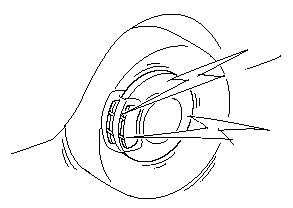
When the disc brake pads become worn, the built-in wear indicators contact the disc plates. This causes a screeching noise to warn that the pads should be replaced.
When you hear this noise, consult an Authorized Mazda Dealer as soon as possible.
WARNING:
Do not drive with worn disc pads:
Driving with worn disc pads is dangerous. The brakes could fail and cause a serious accident. As soon as you hear a screeching noise consult an Authorized Mazda Dealer.
Manual Transaxle Shift Pattern
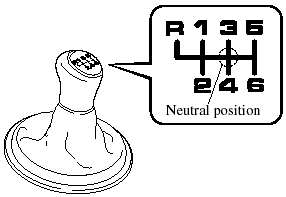
The shift pattern of the transaxle is conventional, as shown.
Depress the clutch pedal all the way down while shifting; then release it slowly.
Your vehicle is equipped with a device to prevent shifting to R (reverse) by mistake.
Push the shift lever downward and shift to R.
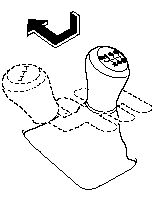
WARNING:
Do not use sudden engine braking on slippery road surfaces or at high speeds:
Shifting down while driving on wet, snowy, or frozen roads, or while driving at high speeds causes sudden engine braking, which is dangerous.
The sudden change in tire speed could cause the tires to skid. This could lead to loss of vehicle control and an accident.
Be sure to leave the shift lever in 1 or R position and set the parking brake when leaving the vehicle unattended:
Otherwise the vehicle could move and cause an accident.
CAUTION:
 Keep your foot off the clutch pedal
except when shifting gears. Also, do not use the clutch to hold the vehicle on an
upgrade. Riding the clutch will cause needless clutch wear and damage.
Keep your foot off the clutch pedal
except when shifting gears. Also, do not use the clutch to hold the vehicle on an
upgrade. Riding the clutch will cause needless clutch wear and damage.
 Make sure the vehicle comes to
a complete stop before shifting to R.
Make sure the vehicle comes to
a complete stop before shifting to R.
Shifting to R while the vehicle is still moving may damage the transaxle.
NOTE:
If shifting to R is difficult, shift back into neutral, release the clutch pedal, and try again.
Recommendations for Shifting
Upshifting
For normal acceleration, we recommend these shift points.
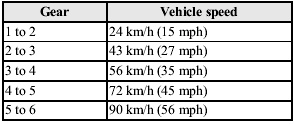
For cruising
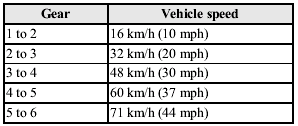
Downshifting
When you must slow down in heavy traffic or on a steep upgrade, downshift before the engine starts to overwork. This reduces the chance of stalling and gives better acceleration when you need more speed.
On a steep downgrade, downshifting helps maintain safe speed and prolongs brake life.


